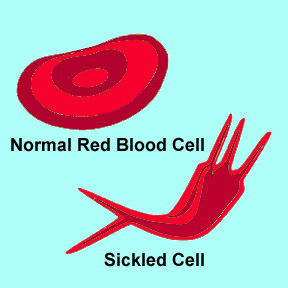By Lorena Madrigal, PhD.
Athletes sickle cell trait (SCT) athletes are at risk of suffering a potentially life-threatening condition called exertional sickling, with heat, dehydration, asthma, high-intensity exercise and high altitude increasing that risk. But why do some SCT athletes never suffer from excertional sickling or heat illness while others do (with some cases resulting in death)? A new study hopes to answer that question.

More than one mutation
When parents learn that they and/or their children carry SCT, they are usually told that the condition is most likely benign. In contrast with sickle cell anemia individuals (SCA), who carry two sickle cell genes, SCT individuals may never have a sickling crisis. Interestingly, studies on sickle cell anemia patients may help us understand why SCT is sometimes benign and why it is sometimes deadly.
Studies on SCA individuals have shown that there is much variation: while some suffer pain, frequent sickling crises and relatively poor health, others have infrequent crises, a normal growth pattern and a virtually normal health.
Genetic studies have helped clarify this variation by showing that sickle cell hemoglobin is caused by more than one mutation, and that these mutations do not produce the same pathology. More specifically, while the mutation produces the same hemoglobin protein in all cases, each one of these mutations is associated with different genetic modifiers, which cause the mutation to produce pathology ranging from very severe to very benign. The set of genetic modifiers surrounding the Hb S gene itself is called a haplotype.
Looking for answers
Although doctors working with sickle cell anemic patients know that haplotypes influence the individual pathology of SCA, no study has been carried out to determine if the haplotypes in SCT athletes may explain why some experience exertional sickling or heat illness and why others do not. Indeed, it is quite possible that your child's athletic trainer and sports medicine doctor are unaware of the existence of different haplotypes.
A research team from the University of South Florida and Arizona State University is conducting a study sponsored by the NCAA in order to determine if athletes' haplotypes are associated with events such as excertional sickling or heat illness.
In order to complete the study, researchers need more subjects, so we are reaching out to you, the parents of SCT collegiate athletes, to encourage your son or daughter to participate in this study. All we are asking from the participants is that they complete a 20-minute survey on their training experiences, and that they furnish us with a DNA sample from a cheek swab.
Privacy assured
The results of the study will not be released to the athletic director or the collegiate sports program. The DNA analysis will be done by members of the team who do not know the identity of the participant, and the survey will be reviewed by a clinician who will not have knowledge of the participant's DNA. Therefore, anonymity will be completely assured. Indeed, samples will be destroyed after the analysis.
If you would like more information about this study please contact the Principal Investigator, Carroll Flansburg, at 802-585-1054 or cflansbu@mail.usf.edu. We really need your help!
Lorena Madrigal, PhD. Is a biological anthropologist at the University of South Florida. She is currently the president of the American Association of Physical Anthropologists and she is a Fellow of the American Association for the Advancement of Science (AAAS). Carroll Flansburg is a graduate student in biological anthropology and public health at the University of South Florida. Dr. Madrigal and Ms Flansburg are deeply committed to finding an explanation for training difficulties in sickle cell trait athletes. Dr. Madrigal can be reached at madrigal@usf.edu.
Sources:
1. Adorno EV, Zanette A, Lyra I, Souza CC, Santos LF, Menezes JF, Dupuit MF, Almeida MNT, Reis MEG, and Goncalves MS. The beta-globin gene cluster haplotypes in sickle cell anemia patients from northeast Brazil: A clinical and molecular view. Hemoglobin2004;28(3):267-271.
2. Lettre G, Sankaran VG, Bezerra MAC, Araujo AS, Uda M, Sanna S, Cao A, Schlessinger D, Costa FF, Hirschhorn JN and others. 2008. DNA polymorphisms at the BCL11A, HBS1L-MYB, and beta-globin loci associate with fetal hemoglobin levels and pain crises in sickle cell disease. Proc Natl Acad Sci USA 2008;105(33):11869-11874.
3. Wajcman H, and Riou J. 2009. Globin chain analysis: An important tool in phenotype study of hemoglobin disorders. ClinicalBiochemistry 2009;42(18):1802-1806.








